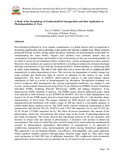A Study of the Morphology of SynthesizedZnO Nanoparticles and their Application in Photodegradation of Dyes

View/
Date
2018-10-14Author
Chebor, Lucy J.
Kituyi, Lusweti
Andala, Dickson
Metadata
Show full item recordAbstract
Environmental pollution by toxic organic contaminants is a global menace and its magnitude is
increasing significantly and so declining water quality has become a global issue. Waste products
produced from the textiles, dyeing, paper and plastic industries are predominantly responsible for
contaminating the water bodies. Organic dyes produce toxic aromatic amines that are
carcinogenic to human beings and harmful to the environment yet they are non-biodegradable. In
an effort to lessen the environmental effects of these dyes, various techniques have been utilized.
However, these methods are expensive and ineffective resulting in intensively coloured discharge
and high concentration of dyes from the treatment facilities. Nanotechnology is a promising field
in waste water treatment. The aim of this study thus was to assess the use of synthesized ZnO
nanoparticles in photo degradation of dyes. This involves the degradation of methyl orange dye
using sunlight and fluorescent light as sources of radiation on the surface of zinc oxide
nanoparticles. The basis of ZnO/UV photo-catalytic process is the semi-conduct optical
stimulation of ZnO as a result of electromagnetic ray absorption. Precipitation technique was
used to synthesize ZnO nanoparticles. By varying experimental conditions, two samples L1 and
L2were synthesizedand characterized using Power X-ray Diffraction (PXRD), Fourier Transform
Infra-Red (FTIR), Scanning Electron Microscopy (SEM) and Energy Dispersive X-ray
Spectroscopy (EDX) methods of analysis. The PXRD results showed diffraction peaks which
were indexed to ZnO reference as per JCPIDS file 80-0075. The size of ZnO nanoparticles was
found to be 26 nm. FTIR spectra showed a broad band at around 430 cm-1 with shoulder shape,
characteristics of Zn-O bond. The images obtained by SEM showed rod shaped clusters of
nanoparticleswere distributed well within a range of 100 nm which is a favourable property to
exhibit better photo catalytic activity. The EDX results showed elemental composition of ZnO
nanoparticles and showed 54% Zn, 44.07% O and 1.93% Mn impurities for L1 and 55.34% Zn,
42.3% O and 2.37%Mn impurities for L2. The effect of process parameters like amount of the
photocatalyst, initial dye concentration and contact time on the extent of photodegradation has
also been investigated. The results showed that percentage removal of the dye increases with
increase in contact time and amount of photocatalyst, it decreases with increase in initial dye
concentration. The results revealed that dyes could be removed by semiconducting nanomaterials
assisted by photocatalytic degradation. Biosynthesis of nanoparticles is an approach of
synthesizing nanoparticles using microorganisms and plants having biomedical applications.
This approach is an environment-friendly, cost-effective, biocompatible, safe, green approach.
Green synthesis includes synthesis through plants, bacteria, fungi, algae etc. They allow large
scale production of ZnO NPs free of additional impurities. NPs synthesized from biomimetic
approach show more catalytic activity and limit the use of expensive and toxic chemicals.
